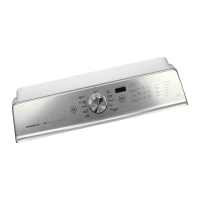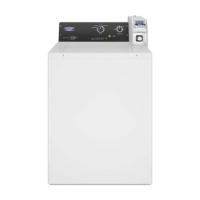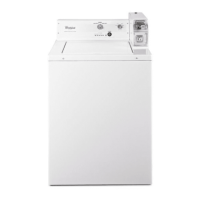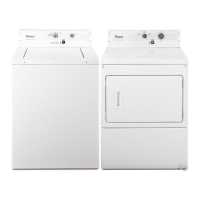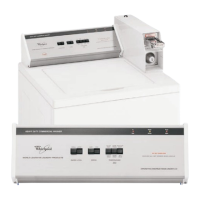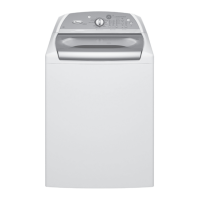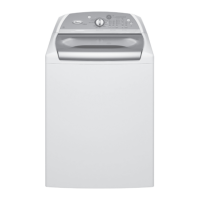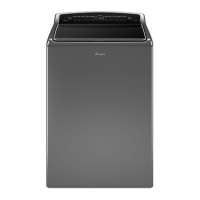Do you have a question about the Whirlpool CATALYST and is the answer not in the manual?
Outlines the purpose and learning outcomes for the service technician.
Warns about electrical shock risk and the necessity of disconnecting power before servicing.
Explains how Catalyst Cleaning uses detergent for improved stain removal via a recirculation system.
Details the insulation and tub wrap for reducing noise and vibration.
Describes the venturi mechanism for drawing bleach into the water flow.
Explains the balance ring with water and oil ballast for load counteraction.
Explains the water level transducer and its function in regulating water levels.
Details the function of the out-of-balance switch in controlling motor operation.
Describes the dual-chambered balance ring containing water and oil for load stabilization.
Identifies and explains the function of bleach, detergent, and fabric softener dispensers.
Details the new inlet valve assembly, including dispenser and fresh water valves, and thermistor.
Explains the location and actuation of the hidden lid switch on the Catalyst Clean model.
Illustrates and describes the washer's control panel layout and functions.
Guides users on selecting appropriate wash cycles based on fabric type.
Details various wash cycles like Whitest Whites, Normal, Permanent Press, Quick Wash, Extra Delicate, Hand Wash, and Favorite Cycle.
Explains how to select wash cycle options like Catalyst Cleaning, Soak, and Rinse Options.
Details how to adjust modifiers like Water Level, Wash/Rinse Temps, Agitation Time, and Signal Volume.
Describes the five water level settings and their effect on agitation speed.
Details the four wash and rinse temperature combinations and suggested fabrics.
Explains ATC's function in maintaining uniform water temperature electronically.
Explains how to adjust the end-of-cycle signal volume.
Diagram showing the location of key components within the washer.
Provides steps to access components located within the washer's console.
Highlights precautions for handling Electronic Discharge Sensitive components.
Details the procedure for removing the electronic control board from its bracket.
Guides on removing the outer cabinet to access internal washer components.
Details how to remove dispenser assemblies and the hidden lid switch from the washer top.
Provides steps for removing bleach, fabric softener, and detergent dispenser assemblies.
Details the procedure for removing the hidden lid switch from the washer top.
Lists components attached to the rear feature panel, including valve assemblies and switches.
Explains how to remove the water inlet valve assembly from the rear feature panel.
Details the procedure for removing the out-of-balance switch from the feature panel.
Identifies the components of the recirculation system for servicing.
Provides a guide to diagnostic tests for various washer components and systems.
Lists and explains error codes displayed by the washer, indicating specific malfunctions.
Provides step-by-step procedures for testing electrical supply and valve systems.
Details tests for console touch switches, LED indicators, and beep functionality.
Checks water inlet relays, temperature sensor, and control board for ATC function.
Verifies water level complaints and tests the water level transducer.
Tests the drain/recirculation pressure switch for proper operation during recirculation.
Presents a detailed wiring diagram of the washer's electrical system.
Outlines the warranty coverage for various parts and the entire unit.
Shows the location of the model and serial number plate on the washer.
Explains the coding system used for model number designation.
Details the components of the serial number designator.
Provides contact numbers for product specifications, warranty, and technical assistance.
Outlines the purpose and learning outcomes for the service technician.
Warns about electrical shock risk and the necessity of disconnecting power before servicing.
Explains how Catalyst Cleaning uses detergent for improved stain removal via a recirculation system.
Details the insulation and tub wrap for reducing noise and vibration.
Describes the venturi mechanism for drawing bleach into the water flow.
Explains the balance ring with water and oil ballast for load counteraction.
Explains the water level transducer and its function in regulating water levels.
Details the function of the out-of-balance switch in controlling motor operation.
Describes the dual-chambered balance ring containing water and oil for load stabilization.
Identifies and explains the function of bleach, detergent, and fabric softener dispensers.
Details the new inlet valve assembly, including dispenser and fresh water valves, and thermistor.
Explains the location and actuation of the hidden lid switch on the Catalyst Clean model.
Illustrates and describes the washer's control panel layout and functions.
Guides users on selecting appropriate wash cycles based on fabric type.
Details various wash cycles like Whitest Whites, Normal, Permanent Press, Quick Wash, Extra Delicate, Hand Wash, and Favorite Cycle.
Explains how to select wash cycle options like Catalyst Cleaning, Soak, and Rinse Options.
Details how to adjust modifiers like Water Level, Wash/Rinse Temps, Agitation Time, and Signal Volume.
Describes the five water level settings and their effect on agitation speed.
Details the four wash and rinse temperature combinations and suggested fabrics.
Explains ATC's function in maintaining uniform water temperature electronically.
Explains how to adjust the end-of-cycle signal volume.
Diagram showing the location of key components within the washer.
Provides steps to access components located within the washer's console.
Highlights precautions for handling Electronic Discharge Sensitive components.
Details the procedure for removing the electronic control board from its bracket.
Guides on removing the outer cabinet to access internal washer components.
Details how to remove dispenser assemblies and the hidden lid switch from the washer top.
Provides steps for removing bleach, fabric softener, and detergent dispenser assemblies.
Details the procedure for removing the hidden lid switch from the washer top.
Lists components attached to the rear feature panel, including valve assemblies and switches.
Explains how to remove the water inlet valve assembly from the rear feature panel.
Details the procedure for removing the out-of-balance switch from the feature panel.
Identifies the components of the recirculation system for servicing.
Provides a guide to diagnostic tests for various washer components and systems.
Lists and explains error codes displayed by the washer, indicating specific malfunctions.
Provides step-by-step procedures for testing electrical supply and valve systems.
Details tests for console touch switches, LED indicators, and beep functionality.
Checks water inlet relays, temperature sensor, and control board for ATC function.
Verifies water level complaints and tests the water level transducer.
Tests the drain/recirculation pressure switch for proper operation during recirculation.
Presents a detailed wiring diagram of the washer's electrical system.
Outlines the warranty coverage for various parts and the entire unit.
Shows the location of the model and serial number plate on the washer.
Explains the coding system used for model number designation.
Details the components of the serial number designator.
Provides contact numbers for product specifications, warranty, and technical assistance.
| Capacity | 5.3 cu. ft. |
|---|---|
| Color | White |
| Wash Cycles | 12 |
| Steam Function | Yes |
| Energy Star Certified | Yes |
| Smart Features | Yes |
